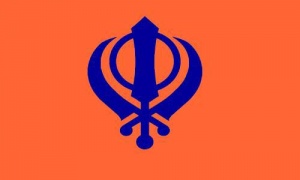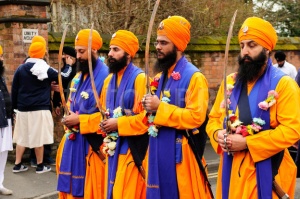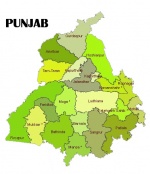Caste: Difference between revisions
(No Concept of 15 Caste in Sikhism in Guru Granth Sahib) |
|||
| Line 22: | Line 22: | ||
[[File:PUNJAB.jpg|thumb|150px|right|Punjab (Sikh Country)]] | [[File:PUNJAB.jpg|thumb|150px|right|Punjab (Sikh Country)]] | ||
==Religious Prohibition in Caste System== | ==Religious Prohibition in Caste System== | ||
Revision as of 22:18, 1 November 2015
|
Sikhism does not endorse caste based distinctions in society that lead to unequal opportunities for some people. In fact, Sikhism completely rejects class or race based distinctions between humans, that leads us to make an inequitable society. Such distinctions have surfaced only due to ill interests of certain section of people, who, on the pretext of making a society more manageable through these classifications, eventually paved the way to an unequal grouping within the human race. This article is just for information purpose and to share how people from different castes came into the Sikh fold. So, please treat this article as a source of general information about this issue and kindly do not amend this article to highlight this important underlying Sikh principle. If you have any comments, please discuss them appropriately here |
Caste or Caste systems are hereditary systems of social class in many parts of the world. This classification is based on social occupation, endogamy, social class, and social group.
Sikhism does not endorse caste based distinctions in society that lead to unequal opportunities for some people. In fact, Sikhism completely rejects class or race based distinctions between humans, that leads us to make an inequitable society. Such distinctions have surfaced only due to ill interests of certain section of people, who, on the pretext of making a society more manageable through these classifications, eventually paved the way to an unequal grouping within the human race.
- Varna is a Sanskrit word which means character, quality or nature. Due to the polysemic nature of Sanskrit, one word can have many meanings. Varna can also mean colour or class. The commentary on the Varna system in the Manusmriti, Counter to these textual classifications, many Hindu texts and doctrines question and disagree with the Varna system of social classification.
- Jāti is a group of clans, tribes, communities and sub communities, and religions in India. Each jāti typically has an association with a traditional job function or tribe and Religious beliefs, Indian society is even today an agglomeration of numerous castes, tribes and religious communities. The tribal and caste groups are endogamous, reproductively isolated populations traditionally distributed over a restricted geographical range. The different caste populations, unlike tribes, have extensive geographical overlap and members of several castes generally constitute the complex village society.
- Backward Caste is independence of other backward classes were given Reservation status, guaranteeing political representation. The Constitution lays down the general principles of affirmative action, with other societal interests and to maintain standards of excellence. This would ensure quality and merit would not suffer. If any seats remain vacant after adopting such norms they shall be filled up by candidates from general categories.
Religious Prohibition in Caste System
As per Caste System described in Manu Smriti, Shudra are considered as lowest caste and untouchable. The post-Vedic texts, particularly Manusmriti mentions outcastes and suggests that they be ostracized. They are:
- Not required to observe any Vedic Rituals,
- Not allowed to Study Vedas,
- Not allowed to hear Sacred Chants of Vedas,
- Not allowed to eat food with High Castes,
- Not allowed to drink water from where High Caste fetch,
- Not allowed to marry high castes,
- Even high caste marry with them; that person gets outcaste,
- Stay away from homes of high caste people.
- Introducing belief that low caste people did bad Karma in Past lives.
- More Fine payments by Lower castes in case of Crime.
- Severe punishment to lower caste if he hurt high caste people but vice versa is not true.
This system was forced on people by various Rigid Hindu Kings; who seek advice of Orthodox Brahmins; whom they respect the most and appointed as ministers. This lead to Exploitation of Weak, Disunity and Division of Loyalities, Foreign Domination, No Healthy exchange of knowledge and ideas, Untouchability and Low Self esteem.
Sikh Heritage Colours
Blue and Orange - Sikh Colours, Khalsa Colours
Guru Gobind Singh and Khalsa
Guru Gobind Singh established Khalsa on will of Supreme. The 5 person are chosen to lead the Sikh Community; who will take all decisions related to Sikh and will protect Gurmat from any foreign intrusion. All 5 were belong to different caste, were given Pahul in Single utensil and named as Khalsa. There is no belief of Caste System in Khalsa. Every one is open for attaining Spiritual Knowledge.






